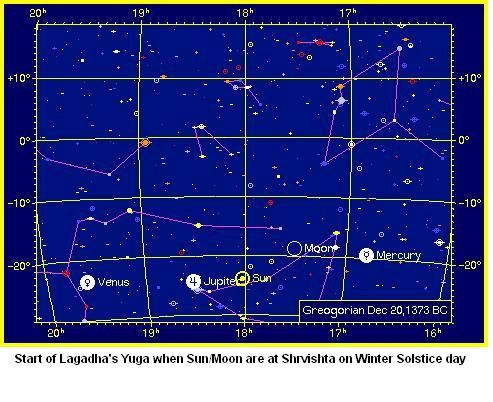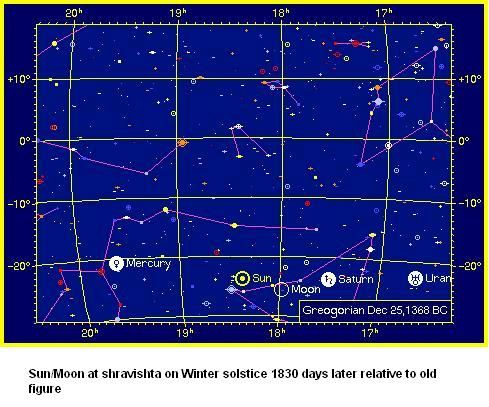| |
|
|
|
ASTRONOMY IN VEDANGA JYOTHISHYA
Definition of Yuga(YVJ28)
A solar year of 366 days, six ritus, two Ayana’s, twelve months and 5 such years make a Yuga.
Commencement of a Yuga or 5 year sun cycle(RVJ32,RVJ5R,VJ6)
A Yuga starts at bright cycle of Lunar month Magha and ends at end of dark cycle of Pushya. He observes and records Sun and Moon are together at the beginning of nakshatra Shravishta at the time of winter solstice by noting that northern movement of Sun starts. He also observes that when sun and moon reach the half point of Aslesha, the Southern movement starts.

Figure shows Sun and New Moon at Shravishta on the winter solstice day in 1373 BC. Lagadha’s calendar is cyclic with this initial point in his 5-year cycle. It should be noted that, with the data known to us today sun-moon conjunction occurs every 29.53059 days. YVJ identifies that 62 conjunctions occur in a Yuga. Thus 62 such conjunctions correspond to 1830.89 solar days.

In the figure Sun moon are together near Winter Solstice 1830 days later. (Dec 20 1373 to Dec 25 1368). But Sun is nearly 5 degrees away from Solstice for Moon to catch up. In the next Yuga cycle it is 10 days away and 15 days away in third Yuga. After that it shrinks again to 10, 5 and zero days from Winter Solstice.
Lagadha by observation has identified this property of conjunction every nearly 5 years (1830 days) and used it as the basis for his Vedanga Jyotishya calendar.. Hence his definition of a year of 1830/5 or 366 days is provided in YVJ28.C. Corrections to this anomaly, would appear to require that Solstice be observed and corrections made
Yuga description has the following identities:
Five years of 366 solar days or 1830 days (YVJ28)
Moon rising in the east over Yuga 1768 (YVJ29)
There are 62 New moons in Yuga (YVJ31)
There are 67 moon visits to each nakshatra in a Yuga (YVJ31)
Sun stays in each nakshatra for 13 days (YVJ39)
Sun visits 135 Nakshatras in a Yuga (YVJ29)
Moon’s North-south Ayana in a Yuga is 134 (YVJ30)
|
|

